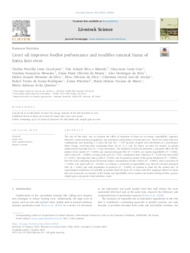Licuri oil improves feedlot performance and modifies ruminal fauna of Santa Inês ewes.
Licuri oil improves feedlot performance and modifies ruminal fauna of Santa Inês ewes.
Author(s): CAVALCANTI, C. P. L.; MACEDO, T. J. S. e; GOIS, G. C.; MENEZES, V. G.; MONTE, A. P. O. do; SILVA, A. D. da; SILVA, D. J. M. da; SILVA, E. O. da; ARAUJO, G. G. L. de; RODRIGUES, R. T. de S.; WISCHRAL, A.; MATOS, M. H. T. de; QUEIROZ, M. A. A.
Summary: The aim of this study was to evaluate the effect of inclusion of licuri oil on intake, digestibility, ingestive behavior, rumen protozoa population, and productive performance of Santa In?es ewe. Thirty-two Santa In?es ewe (multiparous, non-lactating, 2?4 years old and 36.7 ± 0.87 kg body weight) were distributed in a randomized block design, receiving diets containing licuri oil (0, 2, 4, and 5% based on total dry matter) in partial replacement of ground corn (n = 8 per treatment). The inclusion of licuri oil promoted a quadratic effect for the intakes of dry matter (P = 0.008), and neutral detergent fiber (P = 0.004), dry matter digestibility (P = 0.004), ether extract (P < 0.0001), average daily gain (P = 0.01), rumination time (min/day; P = 0.039 and min/g DM; P = 0.041), chewing time (min/g DM; P = 0.020), and for protozoa counts of the genus Entodinium (P < 0.0001). Ewe fed diets containing licuri oil showed higher consumption of ether extract (P < 0.0001), feed conversion (P = 0.004), and rumen pH (P < 0.0001), in contrast, a reduction in digestibility was observed neutral detergent fiber (P = 0.002) and total population of protozoa (P < 0.0001) in relation to those fed the control diet. In experimental conditions, it is possible to include licuri oil up to 2% in diets with 50% roughage offered to Santa In?es ewe to provide an increase in the intake and digestibility of dry matter and neutral detergent fiber, greater weight gain, and greater total protozoa count.
Publication year: 2022
Types of publication: Journal article
Unit: Embrapa Semi-arid Region
Observation
Some of Embrapa's publications are published as ePub files. To read them, use or download one of the following free software options to your computer or mobile device. Android: Google Play Books; IOS: iBooks; Windows and Linux: Calibre.
Access other publications
Access the Agricultural Research Database (BDPA) to consult Embrapa's full library collection and records.
Visit Embrapa Bookstore to purchase books and other publications sold by Embrapa.

